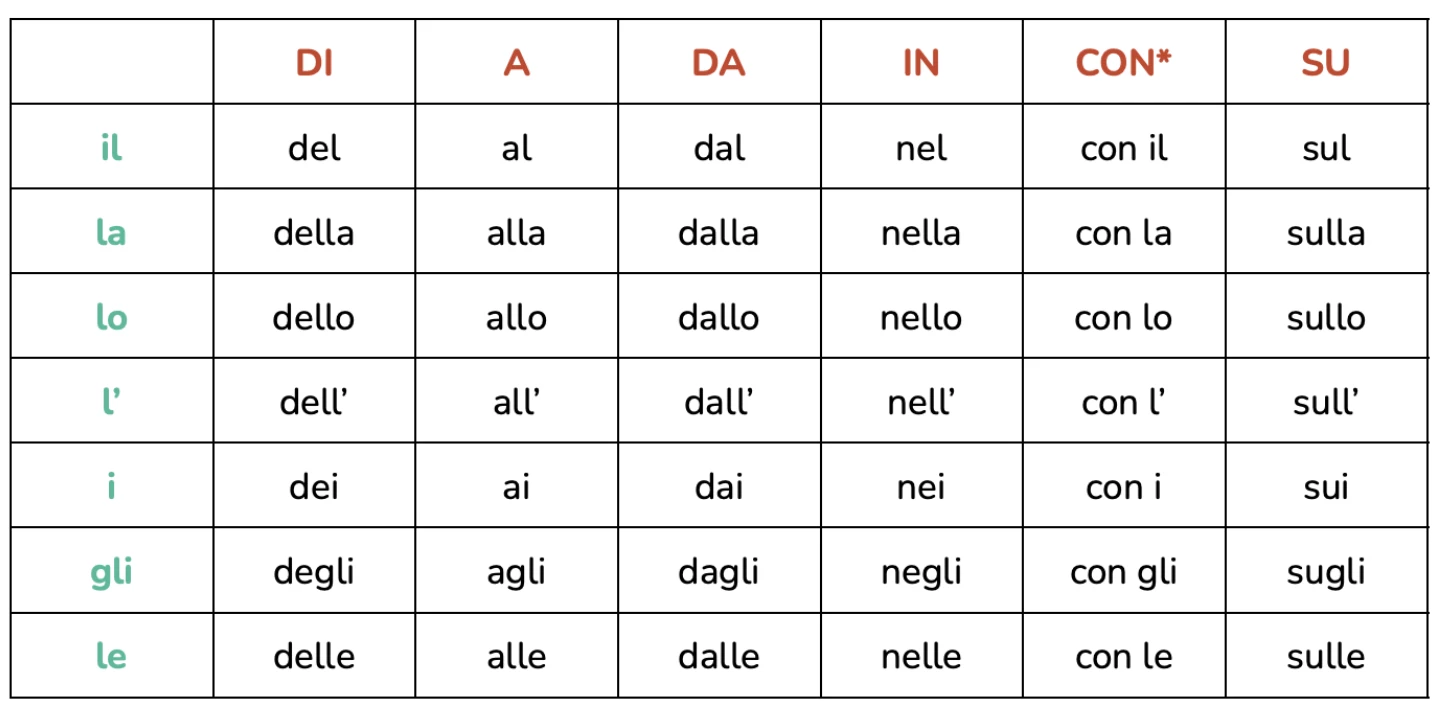What’s a preposition in Italian?
I like to describe prepositions as the glue that holds words together in a sentence. A preposition is a small word that connects different parts of a sentence and affects the meaning of a noun, adjective, or verb. Common prepositions in English include “in,” “at,” “by,” and “for,” among others. Similarly, common Italian prepositions include “di,” “a,” “in,” “tra,” and others.
Simple Prepositions vs. Articulated Prepositions
In Italian, we distinguish between simple and articulated prepositions. Simple prepositions are standalone words that do not change their form based on the gender or number of the noun they modify. The simple prepositions in Italian are “di,” “a,” “da,” “in,” “con,” “su,” “per,” “tra” (or “fra”).
Articulated prepositions, on the other hand, are formed by combining a simple preposition with a definite article, such as “il,” “lo,” “la,” “l’,” or “i,” “gli,” “le,” depending on the gender and number of the noun that follows. For example, “a” + “il” becomes “al,” “di” + “la” becomes “della,” and “su” + “i” becomes “sui.” Articulated prepositions can be modified depending on the gender and number of the noun that follows. However, “tra” (or “fra”), “con,” and “per” are not combined to form articulated prepositions.
Italian Prepositions Chart

Italian Prepositions Chart
 *In some parts of Italy, it’s possible to hear the contracted forms of the preposition “con” with the definite articles, such as “col,” “colla,” “coll’,” “coi,” “cogli,” and “colle. The prepositions “tra” and “fra” are interchangeable and have the same meaning.”Tra,” “fra,” and “per” do not merge with definite articles to form articulated prepositions.
*In some parts of Italy, it’s possible to hear the contracted forms of the preposition “con” with the definite articles, such as “col,” “colla,” “coll’,” “coi,” “cogli,” and “colle. The prepositions “tra” and “fra” are interchangeable and have the same meaning.”Tra,” “fra,” and “per” do not merge with definite articles to form articulated prepositions.
How to Learn Italian Prepositions
I have been teaching Italian to native English speakers for over 10 years, and these are my best pieces of advice on learning Italian prepositions.
ChatGPT
Certainly! Here’s the information presented in a chart:
| Don’t try to learn all prepositions at once. | It may not make sense. Instead, focus on learning general patterns such as using “a” before names of cities and “in” before names of countries. |
| Don’t try to learn all the different uses of “di” or “da” as a beginner. | This knowledge will come with time and years of studying and language use. |
| Learn prepositions in context or chunks. | Focus on recurring combinations, such as “pieno di = full of”, “pronto a = ready to”, or preposition-verb combinations like “parlare con = to talk with”, “venire da = to leave from”, and “consigliare di = to recommend to”. |
| Every preposition has several translations in English. | The rules are defined by context. For example, “tra” means “between” when indicating spaces, but it means “in” when indicating future time. |
| Learn prepositions through reading simplified Italian, like short stories. | Exposure to combinations of nouns and prepositions or verbs and prepositions will help you learn the order of words and the placement of prepositions naturally. Consistency is key. |
The preposition “di”
Main meanings: of, “s”, some.
The most common use of “di” is when it corresponds to the English possessive “‘s” and the noun + noun structure. For example:
- Il libro di italiano (The Italian book)
- La casa dei miei nonni (My grandparents’ house)
- La lezione di Serena (Serena’s lesson)
- Il corso di italiano (The Italian course)
“Di” is also used in partitive constructions with the meaning of “some” or “any,” indicating an indefinite quantity. For example:
- Vorrei del pane (I would like some bread)
- Vorrei dello zucchero (I would like some sugar)
- Hai delle uova? (Do you have any eggs?)
Typically, in this type of sentence, we use articulated prepositions (di + definite article).
“Di” is sometimes used after certain verbs that are typically followed by a second verb. In this case, it works like a connector. For example:
- Finisco di lavorare (I finish work)
- Spero di passare l’esame (I hope to pass the exam)
- Ho voglia di fare una passeggiata (I feel like going for a walk)
“Di” is also used in a number of common expressions, like:
| di giorno | in the daytime |
| di notte | at night |
| di mattina | in the morning |
| di pomeriggio | in the afternoon |
| di tanto in tanto | from time to time |
| di più | more [used after verbs] |
| di fronte | in front of |
| di fretta | in a hurry |
| d’estate, d’inverno | in the summer, in the winter |
| di niente | you’re welcome |
The preposition “a”
Main meanings: in, at, to
The preposition “a” can mean “in” or “to” when referring to a location you are going to, and “at” when referring to a place where you currently are.
There are no clear rules when it comes to usage, but there are a few trends to follow:
We use “a” when the verb “andare” (to go) is followed by another verb. In these sentences, “a” means “to”:
- Vado a studiare (I’m going to study)
- Vado a prendere il pane (I’m going to get some bread)
“A” means in or to when used before the name of a city or a town.
- Vado a Roma (I’m going to Rome)
- Sono a Roma (I’m in Rome)
We use “a” or its contracted forms (articulated prepositions) when we are going to place or you’re at a place. For example:
- Vado al cinema/sono al cinema (I’m going to the cinema I’m at the cinema)
- Vado al lavoro/sono al lavoro (I’m going to work/I’m at work)
- Vado al mare/sono al mare (I’m going to the sea/ I’m at the sea)
Whether to use “a” or “al/alla/ai” depends on the gender and number of the following noun. It’s helpful to learn the most common combinations (e.g., vado al mare) by heart.
“A” or “alle” is used to indicate time:
- Alle 8 (at 8 o’clock)
- A mezzogiorno (at noon)
Common expressions using the prepositions “a”:
| A sinistra | To the left |
| A destra | To the right |
| Al centro di | In the middle of |
| A volte | At times |
| Al mare | To the beach |
| Al lavoro | To work |
| Al teatro | To the theater |
| Al cinema | To the movies |
| A poco a poco | Little by little |
| A letto | To bed |
| All’estero | Abroad |
| A memoria | By heart |
| A causa di | Because of |
The preposition “da”
What does “da” mean in Italian?
Main meanings: from, for, since, by, to
“Da” mainly means “from” when indicating place and is combined with certain verbs like “partire da” (to leave from) and “venire da” (to come from). For example:
- Vengo da Milano (I’m coming from Milan)
- Parto da Roma (I’m leaving from Rome)
“Da” also means “since” or “for” when indicating how long (since when) you’ve been doing something. For instance:
- Vivo a Roma da due anni (I’ve been living in Rome for two years)
- Vivo a Roma dal 2018 (I’ve been living in Rome since 2018 )
- Comincio a studiare da domani (I start studying from tomorrow)
In passive forms, “da” means “by.” For example:
- Questa azienda è stata fondata da mio padre (This company was founded by my father)
- Questo libro è stato scritto dalla mia insegnante (This book was written by my teacher)
“Da” means “to someone” or “at the house of someone” when used with the verbs “andare” and “essere.” The typical mistake here is to use “a” or “in” instead of “da.” For instance:
- Vado dai miei amici (I’m going to my friends) and not vado ai miei amici
- Vado dal medico (I’m going the doctor’s) and not vado al dottore
Finally, “da” is also used before an infinitive and after “molto“, “poco“, “niente“, “troppo“, “qualcosa“, and “nulla“.
- Non c’è molto da fare (There isn’t much to do)
- Hai qualcosa da dire (Do you have anything to say)
“Da”, together with “a”, is also used in time expressions, such as:
- da lunedì a venerdì (Monday through Friday)
- dalle 14 alle 15 (from 2pm to 3pm)
- da marzo a giugno (from March to June)
Common expressions using the prepositions “da”:
| Da domani | Starting tomorrow |
| Da oggi | Starting today |
| Da quanto tempo…? | How long…? |
| Da molto tempo | For a long time |
| Da un lato, dall’altro lato | On one side, on the other side |
The preposition “in”
“In” means “in” before the names of countries, regions, or states.
Example:
- Vado in Italia (I’m going to Italy)
- Vado in Toscana (I’m going to Tuscany)
- Vado in Texas (I’m going to Texas)
“In” means “to” when referring to a location we are going to. This is a similar use of the preposition “a,” which is why it’s sometimes difficult to decide whether to use “a” or “in.” Unfortunately, there are no clear rules for using “in” and “a” when referring to going to a place. The best approach is to learn them in combination with the noun they are followed by.
Common expressions with “in”:
| In chiesa | To church |
| In palestra | To the gym |
| In spiaggia | To the beach |
| In montagna | To the mountains |
| In centro | To the city center |
| In ufficio | To the office |
| In vacanza | On vacation |
| In bagno | To the bathroom |
| In piscina | To the swimming pool |
If you want to learn more about the use of “in” and “a,” I go into further detail in this article (the difference between “in” and “a”).
“In” means “by” when talking about transport.
Example:
- in treno (by train)
- in macchina (by car)
- in aereo (by plane)
- in treno in bici (by train and bike)
The preposition “con”
The preposition “con” has only one meaning and corresponds to the English word “with”.
Example sentences with correct grammar:
- Parlo con mia madre (I talk with my mother)
- Vado al cinema con i miei amici (I go to the cinema with my friends)
The preposition “su”
Main meanings: on, about
The preposition “su” means “on” when indicating location in space. For example:
- Il libro è sul tavolo (The book is on the table)
- Il gatto è sulla sedia (The cat is on the chair)
Another common use of “su” is when indicating the subject of something. In this case, it means “about“. For example:
- Un film sull’Italia (A film about Italy)
- Un libro su Michelangelo (A book about Michelangelo).
In both cases, the preposition “su” is typically used in the form of articulated prepositions (su + definite article: sul, sulla, sui, etc.).
The preposition “per”
Main meanings: for, to
The preposition “per” corresponds to the English word “for“, when indicating a time frame. For instance:
- Vado in palestra per due ore (I go to the gym for two hours)
- Vado in Sicilia per due settimana (I’m going to Sicily for two weeks)
“Per” also means “to + verb” when used with the meaning of “in order to do something” and indicates an aim. For example:
- Studio per migliorare il mio italiano (I study to improve my Italian)
- Faccio una dieta per perdere peso (I’m on a diet to lose weight)
The prepositions “tra/fra”
Main meanings: in, between, among
The most common use of “tra” or “fra” is when they are used to indicate a future time. In this case, tra or fra mean “in” For example:
- Tra due giorni (In two days)
In this case, “tra” is always followed by a period of time.
Typical mistake: using “in” instead of “tra”.
- Vado in vacanza in una settimana. (Wrong)
- Vado in vacanza tra una settimana. (Right)
Another use of “tra” or “fra” is when indicating space and meaning “between” or “among“. For example:
- Firenze si trova tra Roma e Milano. (Florence is located between Rome and Milan.)
“Tra” and “fra” have the same use and are interchangeable.







